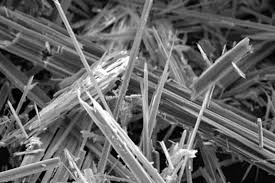Asbestos and other types of hazardous materials (HazMats) are a present-day topic. IAAF wishes to inform and advise on the safe handling of asbestos and other HazMats.
In both modern and ancient Greek, the name for ‘asbestos’ is amiantos (“undefiled”, “pure”), which was adapted into the French ‘amiante‘ and Portuguese ‘amianto‘.
Asbestos today refers to a group of six types of naturally occurring minerals that are made up of fine, durable fibers that are resistant to heat, fire and multiple chemicals.
There are two main groups of fibers: Serpentine and Amphibole class fibers.
– Serpentine class fibers are curly. Chrysotile is the only member of the serpentine class.
– Amphibole class fibers are needle-like. Amosite, crocidolite, tremolite, anthophyllite, and actinolite are members of the amphibole class.
-
Origins
Although asbestos has been mined for over 4.500 years (Finland) recent major mining areas are Canada (where mining was banned in 2012), the Ural in Russia (the biggest mining area today) and China.
-
Uses or applications
The durability of asbestos and its resistance to heat, fire and chemicals makes it very suitable to be used in construction, with applications such as fire retardant coatings, concrete, bricks, pipes and fireplace cement, heat, fire, and acid resistant gaskets, pipe insulation, ceiling insulation, fireproof drywall, flooring, roofing, lawn furniture, and drywall joint compound.
In Japan, especially after 1945, asbestos was used in the manufacture of ammonium sulfate for purposes of rice production, sprayed upon the ceilings, iron skeletons, and walls of railroad cars and buildings, and used for energy efficiency reasons.
-
Health impact
All types of asbestos fibers are known to cause serious health hazards in humans, causing asbestosis and malignant mesothelioma.
More info on Mesothelioma in the Mesothelioma Guide.
Veterans support:
The Mesothelioma Veterans Center is an advocacy organization dedicated to supporting veterans exposed to asbestos during their service. Every branch of the U.S. Armed Forces relied on asbestos for decades. As a result, U.S. veterans account for 33% of all mesothelioma diagnoses. The Mesothelioma Veterans Center provides in-depth information on VA benefits, treatment options and support for families.
The Mesothelioma Veterans Center, an advocacy organization dedicated to support veterans exposed to asbestos during their service. I came across International Asbestos Awareness Foundation while searching for organizations that provide support for those in their community.
Every branch of the Armed Forces relied on asbestos for decades. As a result, U.S. veterans account for 33% of all mesothelioma diagnoses. Our organization provides in-depth information on VA benefits, treatment options and support for families. Our veterans page linked in my signature is a great starting point for those in need. Click on the link below for more information.

